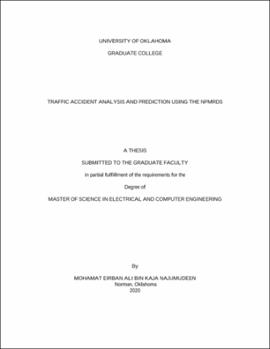| dc.description.abstract | Traffic accidents are incidents caused by collisions between road vehicles or a vehicle with road infrastructures or pedestrians. Traffic accidents are a common cause for non-recurring traffic bottlenecks that, in turn, cause trip delays, an increase in fuel consumption and vehicle usage, and at the worst, loss of life and property. As part of this thesis, we were granted access to the Federal Highway Association’s (FHWA) National Performance Research Management Data Set (NPRMDS), which provide probe speed, average segment speed, reference speed, and travel time per segment, among other information. Statistical analysis is applied to the accident occurrence on Oklahoma roads, especially the I-35 highway corridor for the duration between 2017 and 2020 to show the effect of temporal and spatial factors, such as road segment and its geometry, time of day, day of the week, and month of the year. Multiple methodologies involving machine learning and deep learning were utilized to model accident detection using traffic speed data. Our desired outcome is ensuring a fast reaction time from an emergency response team. We produced a deployable model capable of providing a reliable detection of accident occurrences as an implementable alert system for the concerning state bodies. Using this approach, we were able to train an optimized Random Forest model, which detected 89.68 % of accidents with only a 13.92 % false detection rate. These are promising results for a real-time data environment. Speed turbulence classification was also implemented as a post processing application for classifying samples into free flow, congestion, and incident event based on historical data. The LSTM model outperformed others, especially when modelling is specified to a specific road segment. Accuracy was measured at above 87% in classification with greater than 75% accuracy in correctly classifying congestion and accident events. | en_US |

